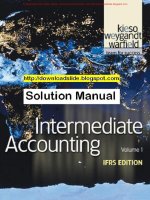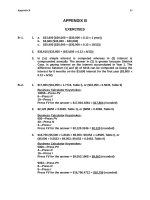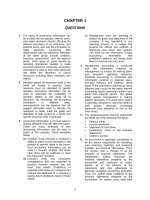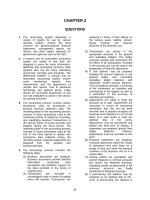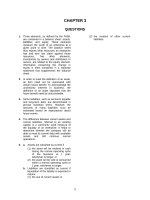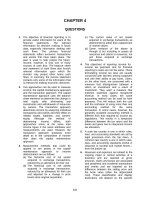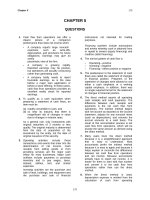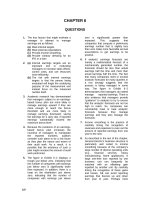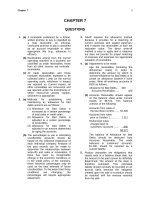Solution manual intermediate accounting 7th by nelson spiceland ch07
Bạn đang xem bản rút gọn của tài liệu. Xem và tải ngay bản đầy đủ của tài liệu tại đây (524.95 KB, 61 trang )
Find more slides, ebooks, solution manual and testbank on www.downloadslide.com
Chapter 7
Cash and Receivables
QUESTIONS FOR REVIEW OF KEY TOPICS
Question 7-1
Cash equivalents usually include negotiable instruments as well as highly liquid investments
that have a maturity date no longer than three months from date of purchase.
Question 7-2
Internal control procedures involving accounting functions are intended to improve the
accuracy and reliability of accounting information and to safeguard the company’s assets. The
separation of duties means that employees involved in recordkeeping should not also have physical
responsibility for assets.
Question 7-3
Management must document the company’s internal controls and assess their adequacy. The
auditors must provide an opinion on management’s assessment. The Public Company Accounting
Oversight Board’s Auditing Standard No. 2 further requires the auditor to express its own opinion on
whether the company has maintained effective internal control over financial reporting
Question 7-4
A compensating balance is an amount of cash a depositor (debtor) must leave on deposit in an
account at a bank (creditor) as security for a loan or a commitment to lend. The classification and
disclosure of a compensating balance depends on the nature of the restriction and the classification
of the related debt. If the restriction is legally binding, then the cash will be classified as either
current or noncurrent depending on the classification of the related debt. In either case, note
disclosure is appropriate. If the compensating balance arrangement is informal and no contractual
agreement restricts the use of cash, note disclosure of the arrangement including amounts involved is
appropriate. The compensating balance can be included in the cash and cash equivalents category of
current assets.
Question 7-5
Trade discounts are reductions below a list price and are used to establish a final price for a
transaction. The reduced price is the starting point for initial valuation of the transaction. A cash
discount is a reduction, not in the selling price of a good or service, but in the amount to be paid by a
credit customer if the receivable is paid within a specified period of time.
Question 7-6
The gross method of accounting for cash discounts considers discounts not taken as part of
sales revenue. The net method considers discounts not taken as interest revenue, because they are
viewed as compensation to the seller for allowing the buyer to defer payment.
Solutions Manual, Vol.1, Chapter 7
© The McGraw-Hill Companies, Inc., 2007
7-1
Find more slides, ebooks, solution manual and testbank on www.downloadslide.com
Answers to Questions (continued)
Question 7-7
When returns are material and a company can make reasonable estimates of future returns, an
allowance for sales returns is established. At a financial reporting date, this provides an estimate of
the amount of future returns for prior sales, and involves a debit to sales returns and a credit to
allowance for sales returns for the estimated amount. Allowance for sales returns is a contra account
to accounts receivable. When returns actually occur in the future reporting period, the allowance for
sales returns is debited.
Question 7-8
Even when specific customer accounts haven’t been proven uncollectible by the end of the
reporting period, bad debt expense properly should be matched with sales revenue on the income
statement for that period. Likewise, since it’s not expected that all accounts receivable will be
collected, the balance sheet should report only the expected net realizable value of that asset. So, to
record the bad debt expense and the related reduction of accounts receivable when the amount hasn’t
been determined, an estimate is needed. In an adjusting entry, we record bad debt expense and
reduce accounts receivable for an estimate of the amount that eventually will prove uncollectible.
If uncollectible accounts are immaterial or not anticipated, or it’s not possible to reliably
estimate uncollectible accounts, an allowance for uncollectible accounts is not appropriate. In these
few cases, any bad debts that do arise simply are written off as bad debt expense.
Question 7-9
The income statement approach to estimating bad debts determines bad debt expense directly
by relating uncollectible amounts to credit sales. The balance sheet approach to estimating future
bad debts indirectly determines bad debt expense by estimating the net realizable value for accounts
receivable that exist at the end of the period. In other words, the allowance for uncollectible
accounts at the end of the period is estimated and then bad debt expense is determined by adjusting
the allowance account to reflect net realizable value.
Question 7-10
The assignment of all accounts receivable in general as collateral for debt requires no special
accounting treatment other than note disclosure of the agreement.
Question 7-11
Accounts receivable factored without recourse are accounted for as the sale of an asset. The
difference between the book value and the proceeds received is recognized as a gain or a loss. The
accounting treatment of receivables factored with recourse depends on whether certain criteria are
met. If the criteria are met, the factoring is accounted for as a sale. If they are not met, the factoring
is accounted for as a loan. In addition, note disclosure may be required.
© The McGraw-Hill Companies, Inc., 2007
7-2
Intermediate Accounting, 4/e
Find more slides, ebooks, solution manual and testbank on www.downloadslide.com
Answers to Questions (concluded)
Question 7-12
When a note is discounted, a financial institution, usually a bank, accepts the note and gives the
seller cash equal to the maturity value of the note reduced by a discount. The discount is computed
by applying a discount rate to the maturity value and represents the financing fee the bank charges
for the transaction.
The four-step process used to account for a discounted note receivable is as follows:
1. Accrue any interest revenue earned since the last payment date (or date of the note).
2. Compute the maturity value.
3. Subtract the discount the bank requires (discount rate times maturity value times the length
of time from date of discounting to maturity date) from the maturity value to compute the
proceeds to be received from the bank (maturity value less discount).
4. Compute the difference between the proceeds and the book value of the note and related
interest receivable. The treatment of the difference will depend on whether the discounting
is accounted for as a sale or as a loan. If it’s a sale the difference is recorded as a loss or
gain on the sale; if it’s a loan the difference is viewed as interest expense or interest
revenue.
Question 7-13
A company’s investment in receivables is influenced by several related variables, to include
the level of sales, the nature of the product or service, and credit and collection policies. The
receivables turnover and average collection period ratios are designed to monitor receivables.
Question 7-14
The items necessary to adjust the bank balance might include deposits outstanding (including
undeposited cash), outstanding checks, and any bank errors discovered during the reconciliation
process. The items necessary to adjust the book balance might include collections made by the bank
on the company’s behalf, service and other charges made by the bank, NSF (nonsufficient funds)
check charges, and any company errors discovered during the reconciliation process.
Question 7-15
A petty cash fund is established by transferring a specified amount of cash from the company’s
general checking account to an employee designated as the petty cash custodian. The fund is
replenished by writing a check to the petty cash custodian for the sum of the bills paid with petty
cash. The appropriate expense accounts are recorded from petty cash vouchers at the time the fund
is replenished.
Solutions Manual, Vol.1, Chapter 7
© The McGraw-Hill Companies, Inc., 2007
7-3
Find more slides, ebooks, solution manual and testbank on www.downloadslide.com
BRIEF EXERCISES
Brief Exercise 7-1
The company could improve its internal control procedure for cash receipts by
segregating the duties of recordkeeping and the handling of cash. Jim Seymour,
responsible for recordkeeping, should not also be responsible for depositing customer
checks.
Brief Exercise 7-2
All of these items would be included as cash and cash equivalents except the U.S.
Treasury bills, which would be included in the current asset section of the balance
sheet as short-term investments.
Brief Exercise 7-3
Income before tax in 2007 will be reduced by $2,500, the amount of the cash
discounts.
$25,000 x 10 = $250,000 x 1% = $2,500
Brief Exercise 7-4
Income before tax in 2006 will be reduced by $2,500, the anticipated amount of
cash discounts.
$25,000 x 10 = $250,000 x 1% = $2,500
© The McGraw-Hill Companies, Inc., 2007
7-4
Intermediate Accounting, 4/e
Find more slides, ebooks, solution manual and testbank on www.downloadslide.com
Brief Exercise 7-5
Estimated returns = $10,600,000 x 8% = $848,000
Less: Actual returns
(720,000)
Remaining estimated returns
$128,000
Sales returns .................................................................. 128,000
Allowance for sales returns ......................................
128,000
Inventory ......................................................................
Cost of goods sold ($128,000 x 60%) ...........................
76,800
76,800
Brief Exercise 7-6
(1) Bad debt expense = $1,500,000 x 2% = $30,000
(2) Allowance for uncollectible accounts:
Beginning balance
$25,000
Add: Bad debt expense
30,000
Deduct: Write-offs
(16,000)
Ending balance
$39,000
Solutions Manual, Vol.1, Chapter 7
© The McGraw-Hill Companies, Inc., 2007
7-5
Find more slides, ebooks, solution manual and testbank on www.downloadslide.com
Brief Exercise 7-7
(1) Allowance for uncollectible accounts:
Beginning balance
$ 25,000
Deduct: Write-offs
(16,000)
Required allowance
(33,400)*
Bad debt expense
$24,400
(2) Required allowance = $334,000** x 10% = $33,400*
Accounts receivable:
Beginning balance
Add: Credit sales
Deduct: Cash collections
Write-offs
Ending balance
$ 300,000
1,500,000
(1,450,000)
(16,000)
$ 334,000**
Brief Exercise 7-8
Allowance for uncollectible accounts:
Beginning balance
Add: Bad debt expense
Deduct: Required allowance
Write-offs
© The McGraw-Hill Companies, Inc., 2007
7-6
$30,000
40,000
(38,000)
$32,000
Intermediate Accounting, 4/e
Find more slides, ebooks, solution manual and testbank on www.downloadslide.com
Brief Exercise 7-9
Credit sales
Deduct: Cash collections
Write-offs
Year-end balance in A/R
Beginning balance in A/R
$8,200,000
(7,950,000)
(32,000)*
(2,000,000)
$1,782,000
*Allowance for uncollectible accounts:
Beginning balance
$30,000
Add: Bad debt expense
40,000
Deduct: Required allowance
(38,000)
Write-offs
$32,000
Brief Exercise 7-10
2006 interest revenue:
$20,000 x 6% x 1/12 = $100
2007 interest revenue:
$20,000 x 6% x 2/12 = $200
Solutions Manual, Vol.1, Chapter 7
© The McGraw-Hill Companies, Inc., 2007
7-7
Find more slides, ebooks, solution manual and testbank on www.downloadslide.com
Brief Exercise 7-11
Assets decrease by $3,000:
Cash increases by $100,000 x 85% =
Receivable from factor increases by
([15% x $100,000] – $3,000 fee)
Accounts receivable decrease
Net decrease in assets
$ 85,000
12,000
(100,000)
$ (3,000)
Liabilities would not change as a result of this transaction.
Income before income taxes decreases by $3,000, the amount of the factor’s fee.
($100,000 x 3%)
The journal entry to record the transaction is as follows:
Cash (85% x $100,000) .....................................................
Loss on sale of receivables (3% x $100,000).....................
Receivable from factor ([15% x $100,000] – $3,000 fee) .....
Accounts receivable (balance sold)...............................
85,000
3,000
12,000
100,000
Brief Exercise 7-12
Logitech would account for the transfer as a secured borrowing. The receivables
would remain on the company’s books and a liability is recorded for the amount
borrowed plus the bank’s fee.
© The McGraw-Hill Companies, Inc., 2007
7-8
Intermediate Accounting, 4/e
Find more slides, ebooks, solution manual and testbank on www.downloadslide.com
Brief Exercise 7-13
$30,000
450
30,450
(406)
$30,044
Face amount
Interest to maturity ($30,000 x 6% x 3/12)
Maturity value
Discount ($30,450 x 8% x 2/12)
Cash proceeds
Brief Exercise 7-14
Receivables turnover =
$320,000 = 5.33
$60,000*
($50,000 + 70,000) ÷ 2 = $60,000*
Average collection
period
Solutions Manual, Vol.1, Chapter 7
=
365 = 68 days
5.33
© The McGraw-Hill Companies, Inc., 2007
7-9
Find more slides, ebooks, solution manual and testbank on www.downloadslide.com
EXERCISES
Exercise 7-1
Requirement 1
Cash and cash equivalents includes:
a. Balance in checking account
Balance in savings account
b. Undeposited customer checks
c. Currency and coins on hand
f. U.S. treasury bills with 2-month maturity
Total
$13,500
22,100
5,200
580
15,000
$56,380
Requirement 2
d. The $400,000 savings account will be used for future plant expansion and
therefore should be classified as a noncurrent asset, either in other assets or
investments.
e. The $20,000 in the checking account is a compensating balance for a longterm loan and should be classified as a noncurrent asset, either in other
assets or investments.
f. The $20,000 in 7-month treasury bills should be classified as a current asset
along with other temporary investments.
© The McGraw-Hill Companies, Inc., 2007
7-10
Intermediate Accounting, 4/e
Find more slides, ebooks, solution manual and testbank on www.downloadslide.com
Exercise 7-2
Requirement 1
Cash and cash equivalents includes:
Cash in bank – checking account
U.S. treasury bills
Cash on hand
Undeposited customer checks
Total
$22,500
5,000
1,350
1,840
$30,690
Requirement 2
The $10,000 in 6-month treasury bills should be classified as a current asset
along with other temporary investments.
Solutions Manual, Vol.1, Chapter 7
© The McGraw-Hill Companies, Inc., 2007
7-11
Find more slides, ebooks, solution manual and testbank on www.downloadslide.com
Exercise 7-3
Requirement 1
Sales price = 100 units x $600 = $60,000 x 70% = $42,000
November 17, 2006
Accounts receivable ......................................................
Sales revenue.............................................................
42,000
November 26, 2006
Cash (98% x $42,000).......................................................
Sales discounts (2% x $42,000) ........................................
Accounts receivable ..................................................
41,160
840
42,000
42,000
Requirement 2
November 17, 2006
Accounts receivable ......................................................
Sales revenue.............................................................
42,000
December 15, 2006
Cash ..............................................................................
Accounts receivable ..................................................
42,000
© The McGraw-Hill Companies, Inc., 2007
7-12
42,000
42,000
Intermediate Accounting, 4/e
Find more slides, ebooks, solution manual and testbank on www.downloadslide.com
Exercise 7-3 (concluded)
Requirement 3
Requirement 1:
November 17, 2006
Accounts receivable ......................................................
Sales revenue (98% x $42,000) .....................................
41,160
November 26, 2006
Cash ..............................................................................
Accounts receivable ..................................................
41,160
41,160
41,160
Requirement 2:
November 17, 2006
Accounts receivable ......................................................
Sales revenue (98% x $35,000) .....................................
December 15, 2006
Cash ..............................................................................
Accounts receivable ..................................................
Interest revenue .........................................................
Solutions Manual, Vol.1, Chapter 7
41,160
41,160
42,000
41,160
840
© The McGraw-Hill Companies, Inc., 2007
7-13
Find more slides, ebooks, solution manual and testbank on www.downloadslide.com
Exercise 7-4
Requirement 1
Sales price = 1,000 units x $50 = $50,000
July 15, 2006
Accounts receivable ......................................................
Sales revenue.............................................................
50,000
July 23, 2006
Cash (98% x $50,000).......................................................
Sales discounts (2% x $50,000) ........................................
Accounts receivable ..................................................
49,000
1,000
50,000
50,000
Requirement 2
July 15, 2006
Accounts receivable ......................................................
Sales revenue.............................................................
50,000
Aug. 15, 2006
Cash ..............................................................................
Accounts receivable ..................................................
50,000
© The McGraw-Hill Companies, Inc., 2007
7-14
50,000
50,000
Intermediate Accounting, 4/e
Find more slides, ebooks, solution manual and testbank on www.downloadslide.com
Exercise 7-5
Requirement 1
July 15, 2006
Accounts receivable ......................................................
Sales revenue (98% x $50,000) .....................................
49,000
July 23, 2006
Cash ..............................................................................
Accounts receivable ..................................................
49,000
49,000
49,000
Requirement 2
July 15, 2006
Accounts receivable ......................................................
Sales revenue (98% x $50,000) .....................................
August 15, 2006
Cash ..............................................................................
Accounts receivable ..................................................
Interest revenue .........................................................
Solutions Manual, Vol.1, Chapter 7
49,000
49,000
50,000
49,000
1,000
© The McGraw-Hill Companies, Inc., 2007
7-15
Find more slides, ebooks, solution manual and testbank on www.downloadslide.com
Exercise 7-6
Requirement 1
$67,500 (1.5% x $4,500,000)
Requirement 2
Allowance for uncollectible accounts
Balance, beginning of year
Add: Bad debt expense for 2006 (1.5% x $4,500,000)
Less: End-of-year balance
Accounts receivable written off
$42,000
67,500
(40,000)
$69,500
Requirement 3
$69,500 — the amount of accounts receivable written off.
© The McGraw-Hill Companies, Inc., 2007
7-16
Intermediate Accounting, 4/e
Find more slides, ebooks, solution manual and testbank on www.downloadslide.com
Exercise 7-7
Requirement 1
To record the write-off of receivables.
Allowance for uncollectible accounts ............................
Accounts receivable ..................................................
21,000
21,000
To record the collection of a receivable previously written off.
Accounts receivable ......................................................
Allowance for uncollectible accounts ........................
1,200
Cash ..............................................................................
Accounts receivable ..................................................
1,200
1,200
1,200
Allowance for uncollectible accounts:
Balance, beginning of year
Deduct: Receivables written off
Add: Collection of receivable previously written off
Balance, before adjusting entry for 2006 bad debts
$32,000
(21,000)
1,200
12,200
Required allowance: 10% x $625,000
Bad debt expense
(62,500)
$50,300
To record bad debt expense for the year.
Bad debt expense ..........................................................
Allowance for uncollectible accounts ........................
50,300
50,300
Requirement 2
Current assets:
Accounts receivable, net of $62,500 in allowance
for uncollectible accounts
Solutions Manual, Vol.1, Chapter 7
$562,500
© The McGraw-Hill Companies, Inc., 2007
7-17
Find more slides, ebooks, solution manual and testbank on www.downloadslide.com
Exercise 7-8
Using the direct write-off method, bad debt expense is equal to actual write-offs.
Collections of previously written-off receivables are recorded as revenue.
Allowance for uncollectible accounts:
Balance, beginning of year
Deduct: Receivables written off
Add: Collection of receivables previously written off
Less: End of year balance
Bad debt expense for the year 2006
$17,280
(17,100)
2,200
(22,410)
$20,030
Exercise 7-9
($ in millions)
Allowance for uncollectible accounts:
Balance, beginning of year
Add: Bad debt expense
Less: End of year balance
Write-offs during the year
$242
44
(166)
$120*
Accounts receivable analysis:
Balance, beginning of year ($5,196 + 242)
Add: Credit sales
Less:Write-offs*
Less: Balance end of year ($5,890 + 166)
Cash collections
© The McGraw-Hill Companies, Inc., 2007
7-18
$ 5,438
36,835
(120)
(6,056)
$36,097
Intermediate Accounting, 4/e
Find more slides, ebooks, solution manual and testbank on www.downloadslide.com
Exercise 7-10
Requirement 1
June 30, 2006
Note receivable .............................................................
Sales revenue.............................................................
30,000
December 31, 2006
Interest receivable .........................................................
Interest revenue ($30,000 x 6% x 6/12) ...........................
900
March 31, 2007
Cash [$30,000 + ($30,000 x 6% x 9/12)] ...............................
Interest revenue ($30,000 x 6% x 3/12) ...........................
Interest receivable (accrued at December 31) ..................
Note receivable .........................................................
30,000
900
31,350
450
900
30,000
Requirement 2
2006 income before income taxes would be understated by $900
2007 income before income taxes would be overstated by $900.
Solutions Manual, Vol.1, Chapter 7
© The McGraw-Hill Companies, Inc., 2007
7-19
Find more slides, ebooks, solution manual and testbank on www.downloadslide.com
Exercise 7-11
Requirement 1
June 30, 2006
Note receivable (face amount) ..........................................
Discount on note receivable ($30,000 x 8% x 9/12) ........
Sales revenue (difference) ............................................
30,000
1,800
28,200
December 31, 2006
Discount on note receivable .........................................
Interest revenue ($30,000 x 8% x 6/12) ...........................
1,200
March 31, 2007
Discount on note receivable .........................................
Interest revenue ($30,000 x 8% x 3/12) ...........................
600
Cash .............................................................................
Note receivable (face amount) ......................................
Requirement 2
$ 1,800
÷ $28,200
= 6.38%
12/
x
9
_______
= 8.51%
1,200
600
30,000
30,000
interest for 9 months
sales price
rate for 9 months
to annualize the rate
effective interest rate
© The McGraw-Hill Companies, Inc., 2007
7-20
Intermediate Accounting, 4/e
Find more slides, ebooks, solution manual and testbank on www.downloadslide.com
Exercise 7-12
Requirement 1
Book value of stock
Plus gain on sale of stock
= Note receivable
Interest reported for the year
$16,000
6,000
$22,000
$ 2,200
=
Divided by value of note
10% rate
$ 22,000
Requirement 2
To record sale of stock in exchange for note receivable.
January 1, 2006
Note receivable .............................................................
Investments ...............................................................
Gain on sale of investments.......................................
22,000
16,000
6,000
To accrue interest on note receivable for twelve months.
December 31, 2006
Interest receivable .........................................................
Interest revenue ($22,000 x 10%)..................................
2,200
2,200
Exercise 7-13
1.
2.
3.
4.
a
a
a
a
Solutions Manual, Vol.1, Chapter 7
© The McGraw-Hill Companies, Inc., 2007
7-21
Find more slides, ebooks, solution manual and testbank on www.downloadslide.com
Exercise 7-14
Cash (difference) ............................................................. 439,200
Finance charge expense (1.8% x $600,000) ....................... 10,800
Liability – financing arrangement .............................
450,000
Exercise 7-15
Cash (90% x $60,000).......................................................
Loss on sale of receivables (2% x $60,000) ......................
Receivable from factor ([10% x $60,000] – $1,200 fee) .......
Accounts receivable (balance sold)...............................
54,000
1,200
4,800
60,000
Exercise 7-16
Cash (90% x $60,000).......................................................
Loss on sale of receivables ([2% x $60,000] + $3,000) .......
Receivable from factor ([10% x $60,000] – $1,200 fee) ......
Recourse liability .....................................................
Accounts receivable (balance sold)...............................
© The McGraw-Hill Companies, Inc., 2007
7-22
54,000
4,200
4,800
3,000
60,000
Intermediate Accounting, 4/e
Find more slides, ebooks, solution manual and testbank on www.downloadslide.com
Exercise 7-17
Step 1: Accrue interest earned.
February 28, 2006
Interest receivable .........................................................
Interest revenue ($15,000 x 10% x 2/12) .........................
250
250
Step 2: Add interest to maturity to calculate maturity value.
Step 3: Deduct discount to calculate cash proceeds.
$15,000
750
15,750
(630)
$15,120
Face amount
Interest to maturity ($15,000 x 10% x 6/12)
Maturity value
Discount ($15,750 x 12% x 4/12)
Cash proceeds
Step 4: To record a loss for the difference between the cash proceeds and the
note’s book value.
February 28, 2006
Cash (proceeds determined above) .......................................
Loss on sale of note receivable (difference) .....................
Note receivable (face amount) ......................................
Interest receivable (accrued interest determined above).....
15,120
130
15,000
250
Exercise 7-18
1.
2.
d
c
Solutions Manual, Vol.1, Chapter 7
© The McGraw-Hill Companies, Inc., 2007
7-23
Find more slides, ebooks, solution manual and testbank on www.downloadslide.com
Exercise 7-19
List A
c 1. Internal control
j
2. Trade discount
g 3. Cash equivalents
h 4. Allowance for uncollectibles
i
5. Cash discount
l
6. Balance sheet approach
d 7. Income statement approach
k 8. Net method
a 9. Compensating balance
m 10. Discounting
b 11. Gross method
e 12. Direct write-off method
f 13. Factoring
© The McGraw-Hill Companies, Inc., 2007
7-24
List B
a.
b.
c.
d.
e.
f.
g.
h.
i.
j.
k.
l.
Restriction on cash.
Cash discount not taken is sales revenue.
Includes separation of duties.
Bad debt expense a % of credit sales.
Recognizes bad debts as they occur.
Sale of receivables to a financial institution.
Include highly liquid investments.
Estimate of bad debts.
Reduction in amount paid by credit customer.
Reduction below list price.
Cash discount not taken is interest revenue.
Bad debt expense determined by estimating realizable
value.
m. Sale of note receivable to a financial institution.
Intermediate Accounting, 4/e
Find more slides, ebooks, solution manual and testbank on www.downloadslide.com
Exercise 7-20
Requirement 1
March 17, 2006
Allowance for uncollectible accounts ............................
Accounts receivable ..................................................
1,700
March 30, 2006
Note receivable .............................................................
Cash ..........................................................................
20,000
1,700
20,000
Step 1: To accrue interest earned for two months on note receivable
May 30, 2006
Interest receivable .........................................................
Interest revenue ($20,000 x 7% x 2/12) ...........................
233
233
Step 2: Add interest to maturity to calculate maturity value.
Step 3: Deduct discount to calculate cash proceeds.
$20,000
1,400
21,400
(1,427)
$19,973
Solutions Manual, Vol.1, Chapter 7
Face amount
Interest to maturity ($20,000 x 7%)
Maturity value
Discount ($21,400 x 8% x 10/12)
Cash proceeds
© The McGraw-Hill Companies, Inc., 2007
7-25
